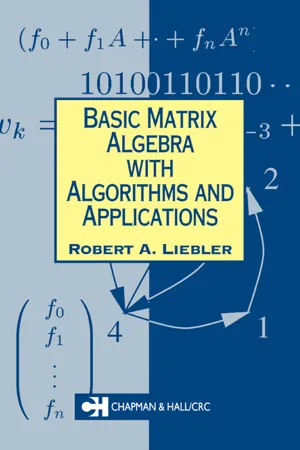
- 264 pages
- English
- ePUB (mobile friendly)
- Available on iOS & Android
Basic Matrix Algebra with Algorithms and Applications
About This Book
Clear prose, tight organization, and a wealth of examples and computational techniques make Basic Matrix Algebra with Algorithms and Applications an outstanding introduction to linear algebra. The author designed this treatment specifically for freshman majors in mathematical subjects and upper-level students in natural resources, the social sciences, business, or any discipline that eventually requires an understanding of linear models. With extreme pedagogical clarity that avoids abstraction wherever possible, the author emphasizes minimal polynomials and their computation using a Krylov algorithm. The presentation is highly visual and relies heavily on work with a graphing calculator to allow readers to focus on concepts and techniques rather than on tedious arithmetic. Supporting materials, including test preparation Maple worksheets, are available for download from the Internet.This unassuming but insightful and remarkably original treatment is organized into bite-sized, clearly stated objectives. It goes well beyond the LACSG recommendations for a first course while still implementing their philosophy and core material. Classroom tested with great success, it prepares readers well for the more advanced studies their fields ultimately will require.
Frequently asked questions
Information
Table of contents
- Cover
- Half Title
- Title Page
- Copyright Page
- Dedication
- Table of Contents
- Preface
- Examples
- Major results/proofs
- 1 Systems of linear equations and their solution
- 2 Matrix number systems
- 3 Diagonalizable matrices
- 4 Determinants
- A pedagogical postscript
- Appendix: The abstract setting
- Selected practice problem answers
- Index